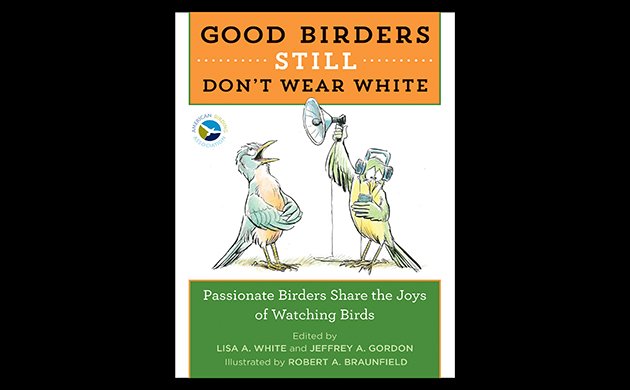
Here are some facts to keep in mind about Good Birders Still Don’t Wear White: Passionate Birders Share the Joys of Watching Birds:
(1) This is not a dress code.
(2) This is a NEW book edited by Lisa A. White and Jeffrey A. Gordon, illustrated by Robert A. Braunfield, just published by Houghton Mifflin Harcourt.
(3) It is a sequel to Good Birders Don’t Wear White: 50 Tips From North America’s Top Birders, the popular 2007 collection of essays. How can you tell the difference, besides the additional word in the title? Well, the cover features a different illustration, a different subtitle, an additional editor, the American Birding Association logo, and, most importantly, the title is in an orange color block and the subtitle is in a green color block. In other words—different plumage.
(4) It is a delightful, engaging book. O.k., that’s opinion, not fact. It is a fact that the book fulfills the promise of its subtitle. The 37 essays by birders, bird artists, photographers, tour leaders, ornithologists, field guide authors, and other members of the tribe (even bloggers!) explore the diverse joys of birding. The essays are brief, specific, light-hearted with passionate cores. The topics and writing styles may differ, but there is a unifying theme underneath it all–that birding in an inclusive community and that the joys being articulated are available to all. Suggestions are offered at the end of each chapter—yes, there are still “tips”! Within the framework of sharing the joy, the tips become gifts from friends.
The authors and their topics are a balanced combination of the expected and unexpected, and even familiar topics contain surprises. Noah Strycker’s essay on “Birding the World: Everything Old is New Again” has political resonance in his description of birds as “global citizens” with no patience for borders. Nate Swick makes a passionate, cogent argument for listing in “County by County: The Joys of Being an Unrepentant, and Utterly Pedantic, Lister,” a striking change from the previous volume, in which several writers bemoaned listers’ tunnel vision. In “Summer of the Sparrow,” actress and ABA board member Lili Taylor relates a dramatic tale of murderous passion directed towards a House Sparrow who has killed the Bluebird babies in her nest boxes. (This story of avian hatred may be the most revolutionary essay in a book full of paeans to birds and birding.)
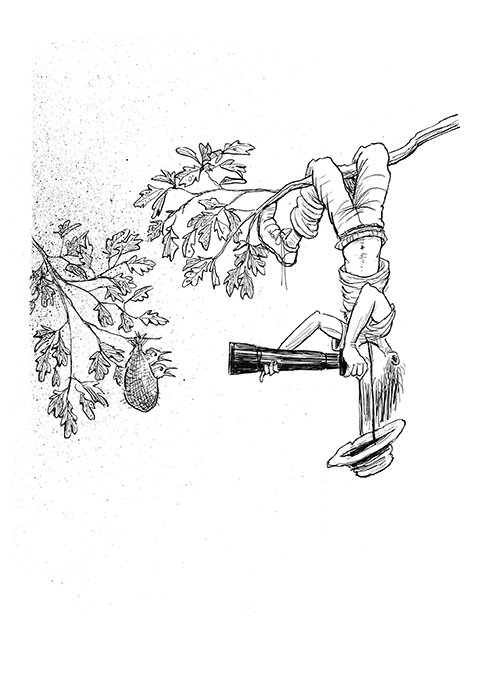
Illustration for Sophie Webb’s “Why I Love to Draw Birds” © 2017 by Robert A. Braunfield. Used by permission of Houghton Mifflin Harcourt. All rights reserved.
There are common themes here: the pull of local birding, whether it be Corey Finger’s New York City or David Lindo’s London or Michael O’Brien’s backyard; the ever-flowing relationship between birding and the arts, whether it be Sophie Webb describing her love of biology and drawing or Catherine Hamilton giving us insight into what colors she sees when drawing birds in Costa Rica or Marie Read observing bird behavior while hidden in a blind or Rick Wright birding in-between visits to the Louvre; the importance of sound, whether it be Nathan Pieplow on the promise of spectrograms or Tom Stephenson on how he discovered simple ways to memorize bird vocalizations or Bill Thompson III on the affinities between music and bird song, musicians and birders. Two of my favorite essays, by ornithologist Donna Dittman and Birding magazine associate editor Ioana Seritan, relate the joys of museum work–working with skins, creating skins–an aspect of birding that doesn’t get enough attention.
Illustration for Ioana Seritan’s “More Than Skin Deep: Working in the Prep Lab at the Museum of Vertebrate Zoology” © 2017 by Robert A. Braunfield. Used by permission of Houghton Mifflin Harcourt. All rights reserved.
Surprisingly, essays on birds themselves (besides Lili’s House Sparrow) focus almost exclusively on birds seen at sea, or close by–Amar Ayyash makes gull identification seem both easy and sexy (it’s a “love-hate relationship”!); Debi Shearwater points out that seabirding is really all about the ocean and conservation; Alvaro Jaramillo touchingly traces his love of pelagics and seabirds back to a childhood adventure in Chile; and Jen Brumfield offers what could be a melodramatic radio play about chasing Jaegers in Ohio. Another surprise is the two pieces on hunting, an interesting change from the essays on bird feeding in volume one. Dorian Anderson finds a moment of connection with a duck hunter during his bicycle big year, and, despite his distaste for the sport, realizes that in hunters we have allies for conservation. In the next essay, J. Drew Lanham draws on years of field experience to give us birders a feeling for what it’s like to hunt wild turkey (noting that he always takes “a bird list from the woods; seldom a life”), concluding with the exact same point.
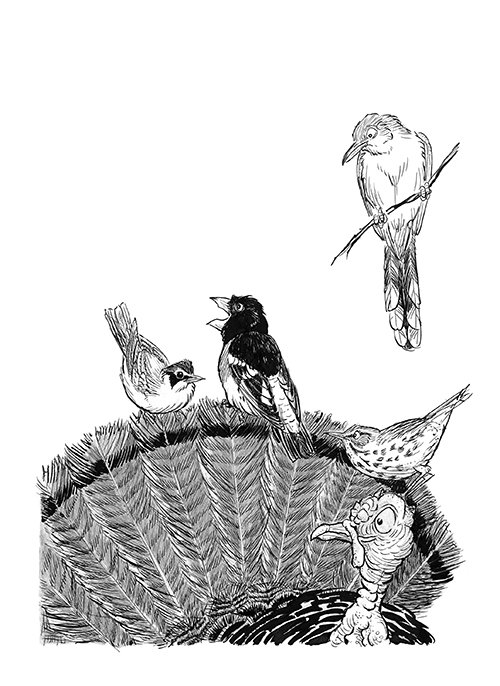
Illustration for J. Drew Lanham’s “Soul Food: Wild Turkeys and Wandering Warblers” © 2017 by Robert A. Braunfield. Used by permission of Houghton Mifflin Harcourt. All rights reserved.
Not surprising, but very worth reading, are the essays on working with young people. I very much enjoyed Jennie Duberstein’s moving story of how, finding herself leading a field trip of refugee children with no common language but English and that not so much, she used birding to teach English. Lesson after lesson–in sharing, observation, writing, and, most importantly, appreciating “the extraordinary in everyday life”–spiral off her creative approach, encapsulating two basic themes of this book–that “everyone has something to teach others” and “there is always more to learn.” Essays by Ted Floyd, Jonathan Rosen, Ann Nightingale describe other ways of teaching and learning and proselytizing. Rosen’s essay is particularly noteworthy in its very personal discussion of birding and dyslexia, just as Pieplow’s piece strikes a chord when he mentions his age-related hearing loss. I’d like to see more essays in the next volume about birding and disabilities (because there is going to be a Good Birders Still Really Don’t Wear White Ever, right Lisa and Jeff?).
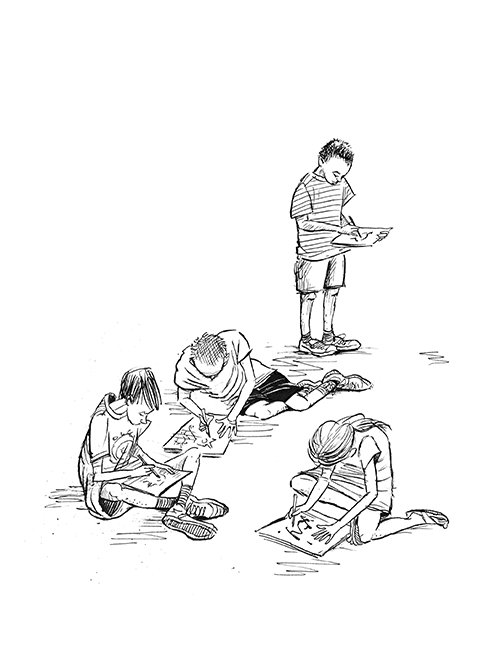
Illustration for Jennie Duberstein’s “Why I Love the Way Birding Helps Us Learn” © 2017 by Robert A. Braunfield. Used by permission of Houghton Mifflin Harcourt. All rights reserved.
Jeffrey A. Gordon, president of the American Birding Association, is co-editor and writer of the book’s Introduction. He points out that birding is a community that values sharing (as opposed to fishing–who knew?) and a community in which an individual–each individual–can make a difference. Being the kind of reader who always wants to know how a book is put together, I was curious about how the contributors were selected and if they were indeed asked to answer the specific question, “What is your birding joy and how can the rest of us share it?” Hopefully, my questions will be answered in a future ABA Blog post. The American Birding Association will receive a portion of the proceeds from sales of this book to support its conservation and community programs. It’s a good fit for the ABA, a book that can be read by birders of all levels and even non-birders. In fact, it’s an excellent book to give that friend or relative who is just at the edge of jumping into the passionate birder pool.
Lisa A. White, editor of both this and the 2007 volume, is executive editor of nature and field guides at Houghton Mifflin Harcourt and one of the people in the publishing world that we need to thank for making sure books on birding continue to be published. Robert A. Braunfield illustrated each essay, reflecting the humor, and in some cases the author, of each piece. (His depiction of Pete Dunne is spot-on; on the other hand, I don’t think Sharon Stiteler would wear pigtails in the bathtub). Braunfield is also a naturalist, and his familiarity with the birding community and his knowledge of birds comes through, as you can see in the illustrations reproduced here.
Illustration for Tom Stephenson’s “Doorknobs, Bird Songs, and Remembering Where You Put Your Car Keys” © 2017 by Robert A. Braunfield. Used by permission of Houghton Mifflin Harcourt. All rights reserved.
This is probably the part of the review where I should talk about the fact that Corey Finger—our 10,000 Birds Corey—is one of the authors published in this collection, and how that will not deter me from writing a balanced review. Well, it’s a bit more than that. Many of the authors here are birding friends and colleagues, and I really wasn’t sure if I should write this review. I was very happy when I started reading and found a book crammed with good writing.
In fact, the quality of writing in this volume is uniformly excellent. We have pieces here from some of the best nature/birding writers and editors around today–Julie Zickefoose, Kenn Kaufmann, Pete Dunne, Jonathan Rosen, Sherri L. Williamson, Steve N. G. Howell, Charles Hagner, to name a few–and fresh voices that represent the future of birding literature, such as Nate Swick, Jennie Duberstein, Ioana Seritan, Nick Lund, and Corey Finger. There are also the essays by birders whose names are familiar but whose claim to fame lie more in birding achievements (big year birder Greg Miller) or birding jobs (Panama tour leader Carlos A. Bethancourt, Cape May Bird Observatory director David A. La Puma) or field guide photography and design (Richard Crossley). The fact that their pieces are well written too makes me think that one byproduct of birding must be some kind of literary ability. Maybe it’s the constant state of acute observation? Or, writing those comments in eBird reports? Hopefully, reading these 37 essays will motivate readers to read the authors’ books and articles or connect with them in other ways, through social media and travel. And join the American Birding Association. These essays are the literary appetizers to engaging in the birding community.
Good Birders Still Don’t Wear White: Passionate Birders Share the Joys of Watching Birds is a book that both birders and non-birders will thoroughly enjoy. For us birders, it provides good, quick reading, inspirational ideas for participating in our passion in new ways, and a sense of connection with talented birders and writers. The book is small and light, and you can slip it into your backpack for reading during those birding lulls or on the plane or at home, when you’re on a break from reading eBird reports. For non-birders, it presents birding at its wide scope, offering diverse possible points of engagement and a portrait of a recreational activity that is so wonderful it can be enjoyed 37 different ways. What is it about birding that brings you joy? And, how would you share that with the rest of us?
————–
Good Birders Still Don’t Wear White: Passionate Birders Share the Joys of Watching Birds
Edited by Lisa A. White and Jeffrey A. Gordon, illustrated by Robert A. Braunfield
Houghton Mifflin Harcourt, March 2017, 288p., 5 x 0.6 x 7 inche
ISBN-10: 0544876091; ISBN-13: 978-0544876095
$13.95 (discounts from the usual suspects); also available in electronic formats, including Kindle and iBook.


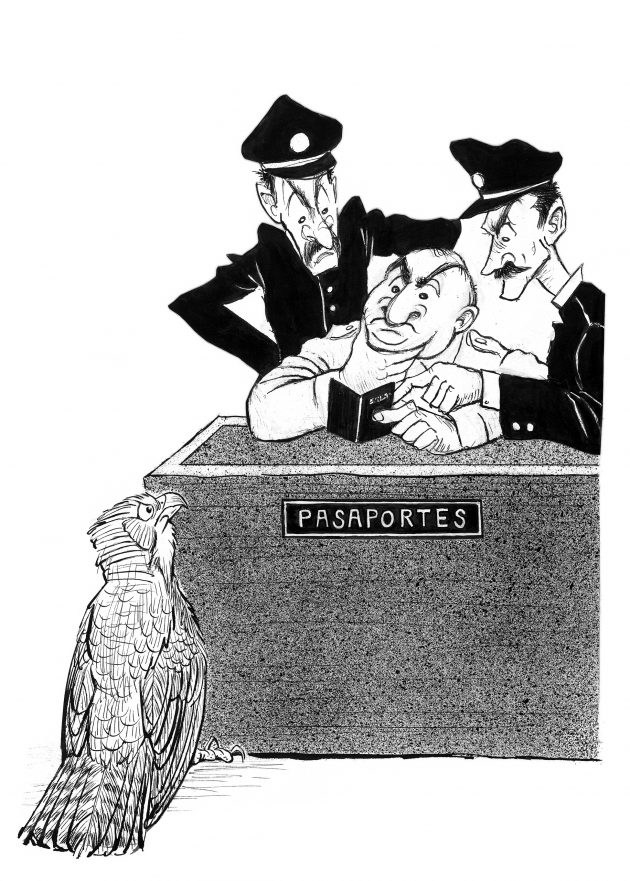
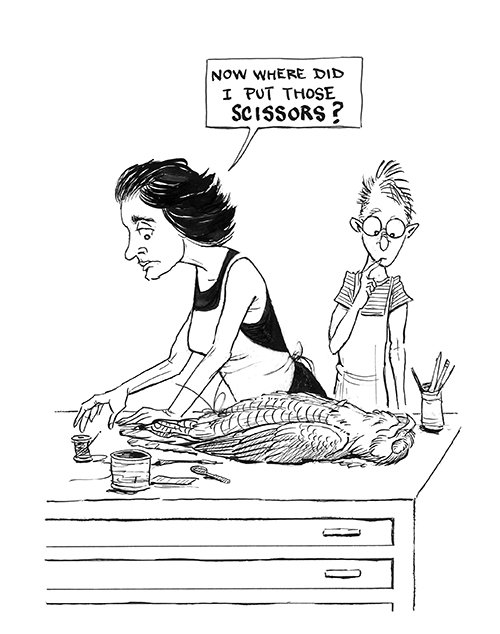
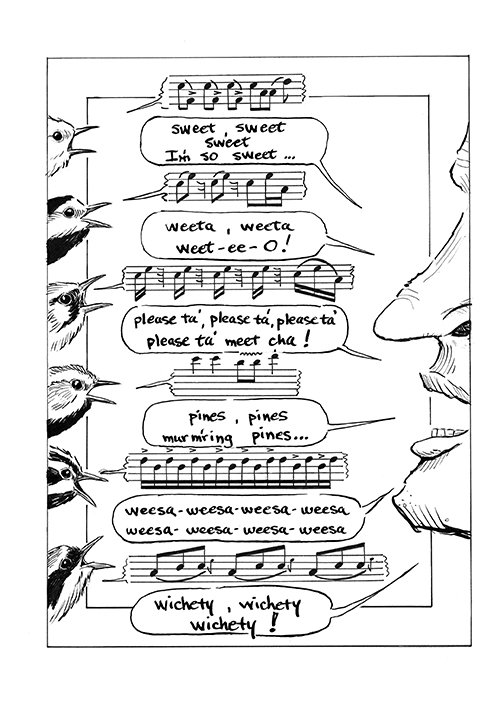











Leave a Comment